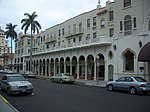The Breakers (hotel)
1925 establishments in FloridaBurned hotels in the United StatesFlorida East Coast RailwayHistoric American Buildings Survey in FloridaHotel buildings completed in 1925 ... and 8 more
Hotel buildings on the National Register of Historic Places in FloridaHotels established in 1925Hotels in Palm Beach, FloridaMediterranean Revival architecture in FloridaNational Register of Historic Places in Palm Beach County, FloridaRailway hotels in the United StatesSeaside resorts in FloridaShingle Style architecture in Florida

The Breakers Palm Beach is a historic, Renaissance Revival style luxury hotel with 538 rooms. It is located at 1 South County Road in Palm Beach, Florida.
Excerpt from the Wikipedia article The Breakers (hotel) (License: CC BY-SA 3.0, Authors, Images).The Breakers (hotel)
North County Road,
Geographical coordinates (GPS) Address Phone number Website Nearby Places Show on map
Geographical coordinates (GPS)
| Latitude | Longitude |
|---|---|
| N 26.713888888889 ° | E -80.038055555556 ° |
Address
Breakers Golf Course
North County Road
33480
Florida, United States
Open on Google Maps









